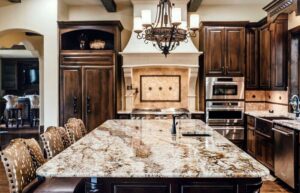The countertop is a key element of any kitchen, both functional and aesthetic. Choosing the right color for your countertop can transform the entire look and feel of your kitchen, enhancing its style and adding harmony or contrast that complements your existing decor. A well-selected countertop color can help tie together all the different elements of your kitchen, creating a cohesive design that is both visually appealing and practical. This article will guide you through selecting a countertop color that perfectly complements your kitchen palette, providing practical tips and insights to help you make a confident decision. We’ll explore everything from understanding your kitchen’s color scheme to matching countertops with existing decor, and even dive into popular trends and lighting considerations to ensure you make an informed choice.
Understanding Your Kitchen’s Color Palette
Before selecting a countertop color, it’s essential to understand your kitchen’s color palette. The palette generally consists of three key elements: primary, secondary, and accent colors. Understanding these elements will help you make a balanced and informed choice that enhances the overall aesthetic of your kitchen.
- Primary Colors: These are the dominant colors in the kitchen, usually found on cabinetry and walls. They set the foundation for the room’s overall look and are the most prominent visual element. The primary color is typically what defines the kitchen’s personality, whether it’s a soft, neutral tone or a vibrant, striking hue.
- Secondary Colors: These colors are often seen in elements such as the backsplash, flooring, or upholstery, complementing the primary colors. They serve to add depth and complexity to the design, tying different aspects of the kitchen together and supporting the primary color.
- Accent Colors: These are used to add pops of interest, seen in accessories, small appliances, or decor items like rugs or artwork. Accent colors are an excellent way to introduce personality into the kitchen, and they can help draw attention to specific areas, creating focal points.
When assessing your kitchen’s palette, consider whether it follows a specific style. A modern kitchen might use monochromatic tones with a lot of white or grey, while a rustic kitchen might feature warm, earthy tones such as browns, reds, and greens. Understanding your color scheme will help you determine what type of countertop color will either blend in seamlessly or provide a beautiful contrast. Take time to identify the overall mood you want in your kitchen—is it light and airy, bold and dramatic, or warm and inviting?

Matching Countertops to Existing Decor
One effective approach to choosing a countertop color is to match it with your existing decor, creating a cohesive, unified look. This approach ensures that all the elements in your kitchen work together harmoniously. Here are some factors to consider:
- Cabinetry: Since cabinets are usually the most dominant feature in the kitchen, consider a countertop color that complements or contrasts nicely with your cabinetry. For example, if your cabinets are a warm wood tone, consider a neutral countertop color such as beige or cream. White or light cabinets often pair well with a darker countertop for a striking effect. Matching your countertop to the cabinet color creates a seamless and continuous look, while contrasting them can add depth and visual interest.
- Flooring: Another major visual element is the flooring. If your kitchen flooring has a busy pattern, it’s best to opt for a more subdued countertop color to maintain balance. Alternatively, if the flooring is a single tone, you have the flexibility to either match or create contrast. The key is to ensure that the countertop and flooring do not compete for attention. For instance, if you have hardwood floors with a warm tone, a neutral or cool-toned countertop can balance the warmth, adding harmony to the space.
- Backsplash: The backsplash plays a significant role in the overall kitchen look. Choosing a countertop color that either matches or harmonizes with the backsplash can help to create a seamless look. Alternatively, a contrasting countertop can make both elements stand out, giving your kitchen a designer look. When coordinating the backsplash with the countertop, think about whether you want the two elements to blend subtly or make a statement. A complementary color can make the kitchen feel more cohesive, while a contrasting backsplash and countertop can create a visually dynamic space.
- Appliances: Consider your appliances when selecting a countertop color. Stainless steel appliances often pair well with cool tones like grey or white, whereas black appliances can work well with warmer shades. If your appliances are colorful, you might want to choose a more neutral countertop to let the appliances shine without overwhelming the space.
Choosing Contrasting Countertop Colors
If you want to add some visual interest, selecting a contrasting countertop color is an excellent strategy. Contrasting colors create a dynamic and engaging look, making your countertops the star of the kitchen. This approach can add a modern and sophisticated vibe to the space, as well as provide a clear distinction between different areas of the kitchen.
For example, if you have white or light-colored cabinets, choosing a dark countertop like black granite or deep grey quartz can make a bold statement. This contrast can be particularly effective in a modern or minimalist kitchen where clean lines and striking visual elements are key. Conversely, if your kitchen cabinets are dark, a light-colored countertop can provide a refreshing contrast, creating a balanced yet striking look. This pairing can make the kitchen feel more open and spacious while adding a sense of refinement.
However, it’s important to maintain a sense of harmony when using contrasts. Make sure that the chosen countertop color doesn’t clash with other elements in the kitchen but instead enhances the overall aesthetic. Consider incorporating smaller decor items that tie the contrasting colors together, such as kitchen towels, decorative bowls, or small appliances that pick up on the color of the countertop. This will help create a sense of cohesion, even when using contrasting colors.
Neutrals vs. Bold Colors: Pros and Cons
When deciding on a countertop color, one of the major considerations is whether to go for a neutral or a bold color. Both options have their benefits and drawbacks, and the choice largely depends on your kitchen style and your personal preference.
- Neutral Countertops: Neutrals like white, beige, or grey are popular choices because they are versatile and timeless. They work well with most kitchen styles and are less likely to clash with other elements. Neutrals can also help make a small kitchen feel larger and more open by reflecting light and creating a sense of space. Additionally, neutral countertops offer flexibility if you plan to change other aspects of the kitchen in the future. The downside is that they may not add as much character as a bold color might, and they might feel too plain for homeowners looking for a more distinctive look.
- Bold Countertops: Bold colors, such as deep blue, green, or even red, can add personality and flair to your kitchen. They make a statement and can serve as the focal point of the space. Bold countertops are particularly well-suited to kitchens where the rest of the decor is fairly simple, as they can add an element of surprise and excitement. However, bold colors can be risky—they might become outdated more quickly, and it can be harder to coordinate other elements in the kitchen. Additionally, a bold countertop might limit your options if you decide to redecorate in the future. Bold countertops are best suited to homeowners who are confident in their design choices and want to make a strong style statement.

Lighting Considerations
Lighting plays a crucial role in how your countertop color will appear in your kitchen. The same color can look very different depending on whether it is viewed under natural or artificial lighting. Understanding how lighting affects color perception is essential to making the right choice.
- Natural Light: If your kitchen receives a lot of natural light, it can make lighter countertops appear even brighter and create a more airy and open feeling. On the other hand, dark countertops can look more intense in bright natural light, adding drama and contrast to the space. Consider how much natural light your kitchen gets throughout the day, as this will impact the final appearance of the countertop.
- Artificial Light: Under artificial lighting, colors can change significantly. Warm or cool light bulbs can alter the appearance of your countertop, making it appear either warmer or cooler than it does in natural light. For example, a grey countertop might take on a slightly blueish hue under cool-toned artificial light. Make sure to view samples under both daylight and your kitchen’s artificial light to get an accurate sense of how they will look in your space. Layering different types of artificial lighting—such as overhead, task, and under-cabinet lighting—can also affect how the countertop color appears.
Popular Countertop Color Trends
Trends can provide inspiration, but it’s important to choose a color you will love for years to come. Here are some current countertop color trends that can help inspire your choice:
- Whites and Off-Whites: These remain popular due to their versatility and ability to brighten up the kitchen. White countertops create a clean and classic look that works well with almost any cabinet color or kitchen style.
- Earthy Tones: Browns, greens, and soft beige shades are gaining popularity for their warm, natural look, especially in rustic or farmhouse kitchens. These colors help create a cozy, welcoming atmosphere that makes the kitchen feel like the heart of the home.
- Dark Colors: Deep blacks and charcoals are trending in modern kitchens, creating a bold, sophisticated look that contrasts well with lighter cabinetry. Dark countertops can add a sense of luxury and drama, especially when paired with sleek hardware and fixtures.
- Marble Patterns: Countertops that feature veining, like marble or quartz with marble-like designs, are also popular, offering an elegant and timeless appearance. Marble patterns work well in both traditional and contemporary kitchens, adding a touch of sophistication and luxury.
Material and Texture Matters
The material you choose for your countertop can also influence color perception. Different materials come in various colors and textures, which can affect the way colors are perceived in your kitchen. The material you select can enhance the look of the color and add depth and character to your kitchen design.
- Granite: Granite is available in a wide variety of colors and patterns, from subtle to bold. Its natural variations can add depth and interest, making it a great choice for those who want a unique and natural look. Granite is also durable and resistant to heat, making it a practical option for busy kitchens.
- Quartz: Quartz is a popular choice because it’s available in many colors and often features subtle veining or speckling, giving it a refined look. Quartz countertops are non-porous, making them resistant to staining and easy to maintain. They are an excellent choice for those who want the look of natural stone without the maintenance requirements.
- Marble: Marble is known for its elegance, with classic white and grey veining. It’s a great option for a sophisticated kitchen but can be more challenging to maintain due to its porous nature. Marble countertops require regular sealing to prevent staining, but their timeless beauty makes them worth the extra care for many homeowners.
- Textured Finishes: Matte, honed, or leathered finishes can add texture to your countertops, affecting how light interacts with the color and giving your kitchen a unique look. Textured finishes can make a countertop appear more muted or add an interesting tactile element that enhances the overall design. A honed finish, for example, has a soft, matte appearance that can give a sophisticated, understated look, while a leathered finish adds a slight texture that is both visually and physically appealing.
Practical Tips for Color Selection
Here are some practical tips to help you confidently choose the right countertop color:
- Use Samples: Always obtain samples of the countertop material and bring them into your kitchen. Place them next to your cabinets, backsplash, and flooring to see how they coordinate. Make sure to view the samples at different times of the day under various lighting conditions to get an accurate sense of how the color will look in your space. Don’t rush this step—taking your time with samples can prevent costly mistakes.
- Consider Maintenance: Some colors show stains and dirt more readily than others. Light-colored countertops may require more frequent cleaning to keep them looking fresh, while very dark colors may show water spots and fingerprints. If you have a busy household, you may want to choose a color that is more forgiving when it comes to daily wear and tear.
- Think Long-Term: Kitchens are often the heart of the home, and trends come and go. Choose a countertop color that you feel you will enjoy for many years, rather than opting for something that might feel outdated in a short time. Neutral and classic colors are generally safer choices for long-term satisfaction, but if you love a bold color, don’t be afraid to incorporate it if it truly reflects your personal style.
- Consult a Professional: If you’re feeling unsure, consulting with a kitchen designer can provide valuable insight and help you make a choice that works well with all the elements of your kitchen. A professional can help you see options you may not have considered and ensure that your choice fits well with your overall kitchen layout and design goals.
Conclusion
Selecting the perfect countertop color is a significant decision that impacts both the aesthetics and functionality of your kitchen. By understanding your existing color palette, considering contrasts, factoring in lighting, and thinking about the overall look you want to achieve, you can confidently choose a countertop color that will beautifully complement your kitchen. Whether you decide on a subtle, neutral tone or a bold, contrasting color, remember that your choice should reflect your personal style and enhance the overall comfort and appeal of your kitchen space.
Take your time, consider all the elements of your kitchen, and don’t be afraid to experiment. Ultimately, your kitchen should be a space that brings you joy and serves your needs, and the right countertop color can make all the difference in achieving that perfect balance of beauty and functionality.





